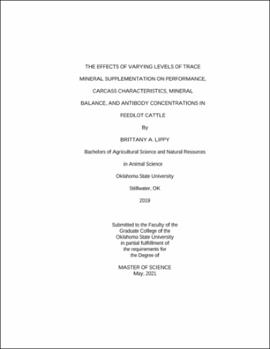| dc.description.abstract | The objective of this experiment was to determine the effects of increasing concentrations of trace minerals (TM) on finishing cattle performance, carcass characteristics, mineral balance, and antibody concentrations. Angus crossbred steers (n = 240; BW = 291 kg +/- 27.4) were stratified by arrival BW and source and randomly assigned to 1 of 4 experimental treatments in a randomized complete block design (12 pens/treatment; 5 steers/pen). Treatments included a negative control (CON) in which cattle received no additional TM supplementation, a requirement treatment (1X) in which cattle received added Co (cobalt carbonate), Cu (cupric sulfate), Fe (ferrous sulfate), I (ethylenediamine dihydriodide), Mn (manganese oxide), Se (sodium selenite), or Zn (zinc oxide) at 2016 Nutrient Requirements of Beef Cattle required levels, a 2 times requirements (2X), and a 4 times requirements (4X) treatment. Selenium was included at 0.1, 0.2, and 0.3 mg/kg for 1X, 2X, and 4X respectively. There was no difference in overall BW, ADG, DMI and G:F due to supplementation (CON vs SUPP P >/= 0.47). There was no difference in marbling score, USDA Yield Grade, back fat, REA, HCW, or dressing percentage due to supplementation (CON vs SUPP P >/= 0.30). One steer was chosen at random from each pen to be evaluated for serum and liver TM status and antibody concentrations to respiratory viruses. There was treatment x day interaction for serum Co, and liver Cu and Se (P < 0.0001). Serum Co was greatest for the 4X treatment from d 28 through harvest. Liver Cu was greatest for the 2X and 4X treatments from d 56 through harvest. Liver Se was greatest for 2X and 4X from d 28 through harvest. There was an effect of day on liver Co, Fe, Mn, Mo, and Zn (P </= 0.0001) and serum Cu, Mn, Mo, Se, and Zn (P </= 0.002). Concentrations for individual TM had different trends over time, however, all reported values were within normal ranges. Serum Zn was greater at harvest (P = 0.02). There was an effect of time on Bovine Viral Diarrhea Virus Type 1A, Bovine Herpesvirus Type 1, Bovine Parainfluenza 3 virus antibody titer concentrations (P </= 0.0001). Overall, TM supplementation above requirements had no effect on cattle performance, carcass characteristics, or immune response but does affect the storage of Cu and Se in the liver as well circulating Co levels. | |
